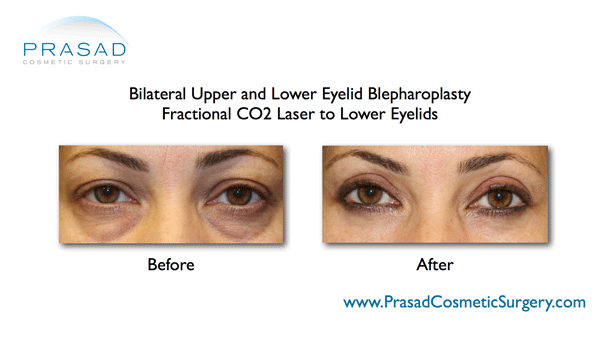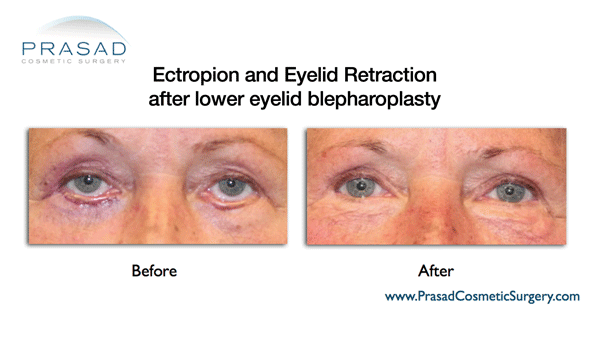Regenerative Treatment for Under Eye Wrinkles and Bags

Upper and lower eyelid surgery, accompanied with regenerative treatment of platelet-rich plasma (PRP) and fractional CO2 laser to treat under eye wrinkles and discoloration.
Puffy eye bags are often the most prominent of cosmetic eye issues. However, as eye bags are more often caused by genetics rather than aging, the under eye area can also be affected by aging changes. Wrinkles on top of eye bags can cause a person to look older and weary. Perhaps the most common issue with patients is they feel younger than they look.
Under Eye Wrinkles – a Common Concern, and Common Pitfall
One of the most common concerns, and also one that causes many problems, is the treatment of under eye wrinkles.
Causes of Wrinkles Under Eyes
Wrinkles under the eyes are caused by factors such as sun exposure and other environmental factors, but they are mostly caused by the natural aging process.
Under Eye Bags and Wrinkles Treatment
Treatment of under eye wrinkles is part of the eyelid specialization as even experienced surgeons often misdiagnose and mistreat wrinkles, and can make the under eye area worse. What happens often in eye bag surgery is that surgeons remove lower eyelid skin in an attempt to tighten skin and reduce wrinkles. However, the actual results are eyelids being pulled down, eyes unable to close because of insufficient skin, or eyelids pulled outwards.

Lower eyelid retraction and ectropion (lower eyelids being exposed outwards) happens when too much eyelid skin is removed in an attempt to treat wrinkles, or unnecessarily removed from blepharoplasty. Restoring lower eyelids is a much more constantly, extensive and specialized process than correct lower eyelid blepharoplasty and proper wrinkle treatment.
Laser Treatment for Under Eye Wrinkles
Another treatment option to reduce under eye wrinkles is the use of laser or heating devices, which actually does work in resurfacing the skin, revealing new skin underneath, and generating collagen to improve wrinkles. However, overuse of laser devices can thin lower eyelid skin, causing more fine lines and wrinkles. Making eyelid skin papery and crepey, and giving it a translucent quality that reveals the inner anatomy of the lower eyelid making them appear dark.
Best Non-Surgical Treatment for Under Eye Wrinkles
In Dr. Amiya Prasad’s experience, he has found that the excision of lower eyelid skin is very rarely justified. In his years of experience, he has found that the main cause of under eye wrinkles is not excess skin quantity, but poor skin quality.
Dr. Prasad approaches under eye wrinkles by improving the quality of the skin. The first step in this approach is build up eyelid skin thickness, with new collagen an important part of this process.
Dr. Prasad first does with the use of platelet-rich plasma (PRP), a serum derived from a patient’s own blood that contains growth and healing factors, the same factors used to heal cuts. These factors are concentrated by spinning a patient’s blood in a centrifuge, and separating the clear yellow plasma from the darker components of the blood.
This is expertly injected into the lower eyelids to build skin quality and thickness, generate collagen, and increase blood supply to the area. This treatment may take several sessions, but eyelid skin is gradually thickened and improved.
Dr. Prasad also uses fractional laser for under eye wrinkles. The use of PRP reduces the need for excess fractional CO2 laser treatment that could potentially thin delicate eyelid skin. Fractional CO2 ablates the top layer of skin, revealing a new, smoother skin layer. Fractional CO2 laser also triggers a collagen production response.
However, micro fractional CO2 laser treatment can only produce so much collagen before it starts thinning the skin around the eyes. The keys to fractional CO2 laser treatment is judicious use, and lessening the frequency of treatment. By using PRP for collagen production, growth factors for skin, and increased blood supply to the area without using excessive heat. Excess fractional CO2 laser treatment can leave eyelid skin crepey and thin, and could make thin lower eyelid skin appear translucent, revealing the inner anatomy and appearing dark.
Treating Under Eye Wrinkles for Darker Skin
Fractional CO2 laser is often not advised for under eye wrinkles in dark skin because it can cause pigmentation issues, but PRP can still be used for any skin tone. For additional collagen generation and skin tightening, the Pellevé radio frequency device can be used in place of the fractional CO2 laser for darker ethnic skin tones.
